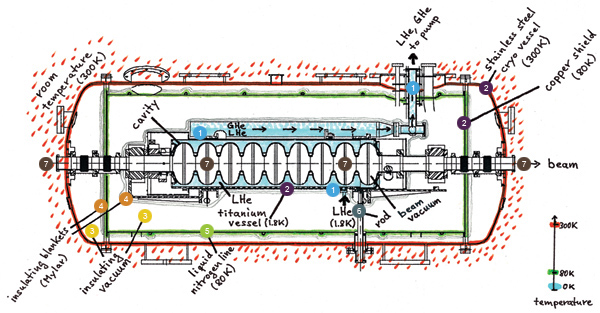Deconstruction: ILC cryogenics
Cavities propel charged particles by transferring energy from electromagnetic waves to the particles, speeding them up. Superconducting cavities are made of material that can conduct electric currents without resistance at a very low temperature. To cool such a cavity close to absolute zero, engineers design cryogenic vessels that submerge cavities in a bath of liquid helium. The proposed International Linear Collider will use 16,000 superconducting cavities made of niobium, and scientists around the world are working on the cryogenic system needed to keep the cavities cool.
 |
| (Click image for larger version) |
|
| 3 | Vacuum–air at greatly reduced pressure–is a great insulator, conducting much less heat than air at normal pressure. This cryogenic vessel operates at a vacuum of 15 torr, a pressure about 50 times lower than normal atmospheric pressure. |
| 4 | Up to 40 layers of aluminized Mylar film, a material also used for helium balloons, cover the copper shield and the titanium cylinder. The resulting blanket, known as superinsulation, reflects heat transferred in the form of infrared radiation. |
| 5 | Liquid nitrogen keeps the temperature of the copper shield at 80 K. The nitrogen flows through a thin pipe that winds around the copper structure. Since copper is a good heat conductor, only a few windings are necessary to carry away excess heat. |
| 6 | When cooling the cavity from room temperature to 1.8 K, the length of the cavity shrinks by a few millimeters. Yet the exact positioning of each cavity is extremely important to make an accelerator with thousands of cavities work. A fiberglass rod, which fits precisely into a hole at the bottom of the titanium cylinder while conducting almost no heat, allows for positioning the cavity with greatest accuracy. |
| 7 | Electromagnetic waves accelerate a particle beam straight through the center of the cavity. To produce the best particle acceleration, the interior surface of the cavity must be highly polished and without impurities. Pumps remove the air from interior of the cavity to keep the surface clean and to minimize the scattering of the beam by air molecules. The vacuum inside the cavity has a pressure of only a millionth of a millitorr. |
Text: Kurt Riesselmann
Graphic: Michael McGee and Dirk Hurd, Fermilab
Click here to download the pdf version of this article.






